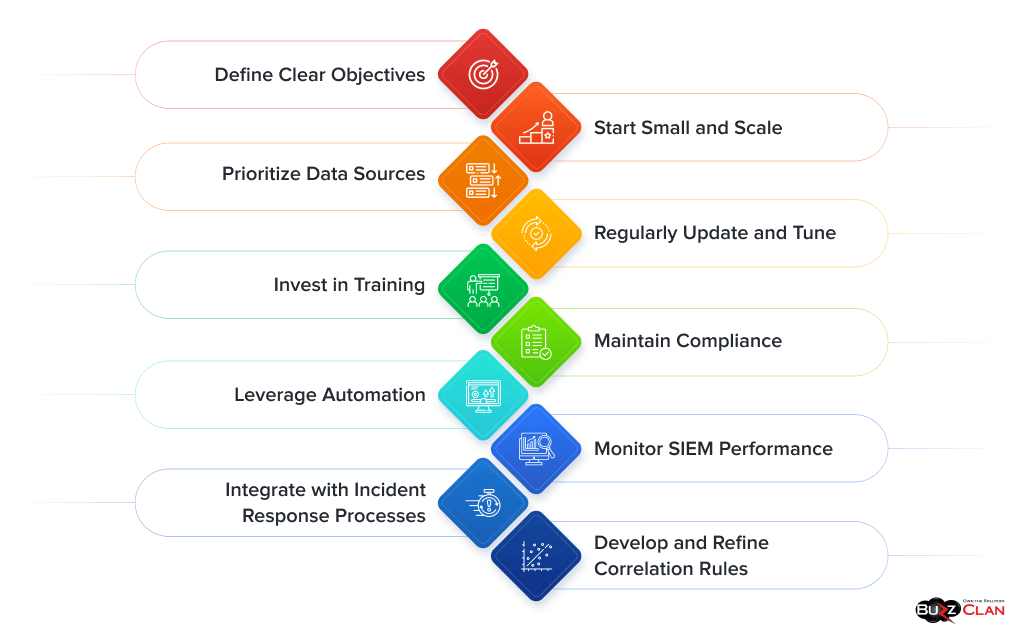Mastering SIEM: Enhance Your Cybersecurity Strategy
Sunita Singhania
Jan 8, 2025
Organizations face an ever-increasing array of cybersecurity threats in today’s rapidly evolving digital landscape. To combat these challenges effectively, businesses need robust tools and strategies to monitor, analyze, and respond to security events across their IT infrastructure. This is where Security Information and Event Management (SIEM) comes into play.
SIEM has become an essential component of modern cybersecurity strategies, providing organizations with real-time visibility into their security posture and the ability to quickly detect and respond to threats. In this comprehensive guide, we’ll explore the ins and outs of SIEM, its key features, benefits, and how it fits into the broader cybersecurity ecosystem.
What is Security Information and Event Management (SIEM)?
Security Information and Event Management (SIEM) is a comprehensive approach to cybersecurity that combines two critical functions: Security Information Management (SIM) and Security Event Management (SEM). SIEM systems collect, analyze, and correlate data from various sources across an organization’s IT infrastructure to provide a holistic view of security events and potential threats.
At its core, an SIEM system serves as a central hub for security-related data, ingesting logs and events from diverse sources such as:
- Network devices (firewalls, routers, switches)
- Servers and workstations
- Applications and databases
- Security tools (antivirus, intrusion detection/prevention systems)
- Cloud services and infrastructure
By aggregating and analyzing this data in real-time, SIEM systems can:
- Detect and alert on potential security incidents
- Provide context and insights for security investigations
- Automate incident response processes
- Generate compliance reports and support audit requirements
- Enhance overall situational awareness of an organization’s security posture
Key Components of a SIEM System
To understand how SIEM works, it’s essential to familiarize yourself with its key components:
- Data Collection: SIEM systems gather log data and security events from various sources across the IT environment. This can be done through agents installed on devices, log collectors, or direct integrations with security tools and applications.
- Normalization: The collected data is standardized into a standard format, making it easier to analyze and correlate events from different sources.
- Correlation Engine: This component analyzes the normalized data to identify patterns, anomalies, and potential security threats. It detects suspicious activities using predefined rules, machine learning algorithms, and threat intelligence.
- Alerting and Incident Management: When potential threats are detected, the SIEM system generates alerts and notifies security teams. It may also initiate automated response actions based on predefined playbooks.
- Dashboard and Reporting: SIEM systems visually represent security data through dashboards, allowing security analysts to monitor the organization’s security posture in real time. They also generate detailed reports for compliance and auditing purposes.
- Data Storage: SIEM solutions typically include a data storage component to retain historical log data and security events for future analysis and compliance requirements.
- Threat Intelligence Integration: Many modern SIEM systems incorporate threat intelligence feeds to enhance their ability to detect and respond to emerging threats.
Benefits of Implementing a SIEM Solution
Organizations that implement SIEM solutions can realize numerous benefits:
- Improved Threat Detection: By correlating data from multiple sources, SIEM systems can identify complex attack patterns and subtle indicators of compromise that might otherwise go unnoticed.
- Faster Incident Response: Real-time alerting and automated response capabilities enable security teams to react quickly to potential threats, reducing the time between detection and mitigation.
- Compliance Support: SIEM solutions help organizations meet regulatory requirements by providing comprehensive logging, reporting, and auditing capabilities.
- Enhanced Visibility: Centralized logging and analysis provide a holistic view of an organization’s security posture, making it easier to identify vulnerabilities and areas for improvement.
- Operational Efficiency: SIEM systems automate many security monitoring and analysis tasks, allowing security teams to focus on high-priority issues and strategic initiatives.
- Forensic Investigation Support: Historical data retention and advanced search capabilities facilitate in-depth investigations of security incidents and support root cause analysis.
- Cost Reduction: While implementing an SIEM solution requires an initial investment, it can lead to long-term cost savings by reducing the impact of security breaches and improving operational efficiency.
SIEM Use Cases
SIEM systems can be applied to various security use cases, including:
- Insider Threat Detection: By monitoring user behavior and access patterns, SIEM solutions can identify potential insider threats, such as unauthorized data access or unusual account activity.
- Advanced Persistent Threat (APT) Detection: SIEM systems can detect indicators of APTs by correlating events over time and identifying subtle patterns that may indicate a long-term, sophisticated attack.
- Compliance Monitoring: Organizations can use SIEM to monitor and report on compliance with various regulations, such as GDPR, HIPAA, or PCI DSS.
- Incident Investigation and Forensics: Security analysts can leverage SIEM data to conduct thorough investigations of security incidents, reconstruct attack timelines, and gather evidence for potential legal proceedings.
- Cloud Security Monitoring: As organizations increasingly adopt cloud services, SIEM solutions can provide visibility into cloud environments and help detect security issues across hybrid and multi-cloud infrastructures.
- IoT Security: SIEM systems can monitor and analyze data from Internet of Things (IoT) devices, helping organizations secure their expanding network of connected devices.
- Fraud Detection: SIEM solutions can help identify fraud attempts in financial and e-commerce systems by analyzing user behavior and transaction data.
Challenges and Considerations
While SIEM systems offer significant benefits, organizations should be aware of potential challenges:
| Challenge | Considerations |
|---|---|
| Data Volume and Scalability | As IT environments grow more complex, SIEM systems must handle increasing volumes of data. Ensuring scalability and performance can be challenging, especially for large enterprises. |
| False Positives | SIEM systems may generate many false-positive alerts, which can overwhelm security teams. Fine-tuning correlation rules and leveraging machine learning algorithms can help reduce false positives over time. |
| Skill Gap | Effectively managing and deriving value from an SIEM solution requires specialized skills. Organizations may need to train or hire dedicated personnel to maximize their SIEM investment. |
| Integration Complexity | Integrating SIEM with various data sources and security tools can be complex and time-consuming. Organizations should carefully plan their SIEM implementation to ensure smooth integration with existing systems. |
| Cost | SIEM solutions, particularly for small and medium-sized businesses, can be expensive. However, the potential cost savings from improved security and operational efficiency often outweigh the initial investment. |
| Data Privacy and Compliance | Organizations must ensure that their SIEM implementation complies with data privacy regulations, particularly when collecting and storing sensitive information. |
The Future of SIEM: Emerging Trends and Technologies
As the cybersecurity landscape continues to evolve, SIEM solutions are adapting to meet new challenges and leverage emerging technologies:
- Cloud-Native SIEM: With the increasing adoption of cloud services, many SIEM vendors are offering cloud-native solutions that can quickly scale and integrate with cloud environments.
- AI and Machine Learning: Advanced analytics techniques are incorporated into SIEM systems to improve threat detection, reduce false positives, and automate response actions.
- User and Entity Behavior Analytics (UEBA): SIEM solutions increasingly incorporate UEBA capabilities to detect anomalous user behavior and potential insider threats.
- Security Orchestration, Automation, and Response (SOAR): Integration of SOAR capabilities with SIEM systems enables more efficient and automated incident response processes.
- Extended Detection and Response (XDR): Some SIEM vendors are expanding their offerings to include XDR capabilities, providing more comprehensive threat detection and response across multiple security layers.
- Open-Source SIEM: Open-source SIEM solutions are gaining popularity, offering organizations more flexibility and cost-effective options for implementing SIEM capabilities.
- Threat Hunting: Advanced SIEM platforms incorporate features to support proactive threat hunting, allowing security teams to search for hidden threats in their environment.
Best Practices for SIEM Implementation and Management

To maximize the value of a SIEM solution, organizations should follow these best practices:
- Define Clear Objectives: Establish specific goals and use cases for your SIEM implementation to guide your deployment and configuration efforts.
- Start Small and Scale: Begin with a focused scope, addressing high-priority use cases first, and gradually expand your SIEM implementation as you gain experience and refine your processes.
- Prioritize Data Sources: Identify the most critical data sources for your security monitoring needs and ensure they are correctly integrated with your SIEM solution.
- Develop and Refine Correlation Rules: Create custom correlation rules tailored to your organization’s threats and environment. Review and update these rules regularly to improve detection accuracy.
- Invest in Training: Provide comprehensive training for your security team to ensure they can effectively use and manage the SIEM system.
- Regularly Update and Tune: Keep your SIEM solution updated with the latest threat intelligence and continuously fine-tune its configuration to improve performance and reduce false positives.
- Integrate with Incident Response Processes: Align your SIEM implementation with your organization’s incident response plan to ensure seamless coordination during security events.
- Monitor SIEM Performance: Regularly assess the performance of your SIEM solution, including its ability to handle data volumes, alert accuracy, and overall effectiveness in detecting threats.
- Leverage Automation: Implement automated response actions for daily, low-risk security events to free up your security team’s time for more complex tasks.
- Maintain Compliance: Ensure your SIEM implementation aligns with relevant regulatory requirements and regularly review its compliance capabilities.
Selecting the Right SIEM Solution
Choosing the right SIEM solution for your organization requires careful consideration of various factors:
- Scalability: Ensure the SIEM solution can handle your current data volume and scale to accommodate future growth.
- Integration Capabilities: Look for an SIEM that easily integrates with your existing security tools and IT infrastructure.
- Ease of Use: Consider the SIEM solution’s user interface and overall usability, as this can significantly impact adoption and effectiveness.
- Customization Options: Evaluate the SIEM system’s flexibility in creating custom rules, reports, and dashboards.
- Analytics Capabilities: Assess the SIEM’s ability to perform advanced analytics, including machine learning and behavior analytics.
- Cloud Support: If your organization leverages cloud services, ensure the SIEM solution can effectively monitor and secure cloud environments.
- Compliance Reporting: Verify that the SIEM can generate the necessary reports to support your compliance requirements.
- Vendor Support and Community: Consider the level of support provided by the SIEM vendor and the availability of community resources for knowledge sharing.
- Total Cost of Ownership: When comparing SIEM solutions, evaluate the long-term costs associated with licensing, maintenance, and required infrastructure.
- Future Roadmap: Review the vendor’s product roadmap to ensure the SIEM solution will continue to evolve and meet your future security needs.
Conclusion
As the threat landscape evolves, SIEM systems adapt to incorporate new technologies and methodologies, such as artificial intelligence, machine learning, and cloud-native architectures. Organizations that effectively implement and manage SIEM solutions will be better equipped to detect, respond to, and mitigate security incidents, ultimately reducing risk and protecting their critical assets.
Understanding the key components, benefits, and best practices associated with SIEM can help security professionals and business leaders make informed decisions about implementing and optimizing these powerful security tools within their organizations.
FAQs

Get In Touch
